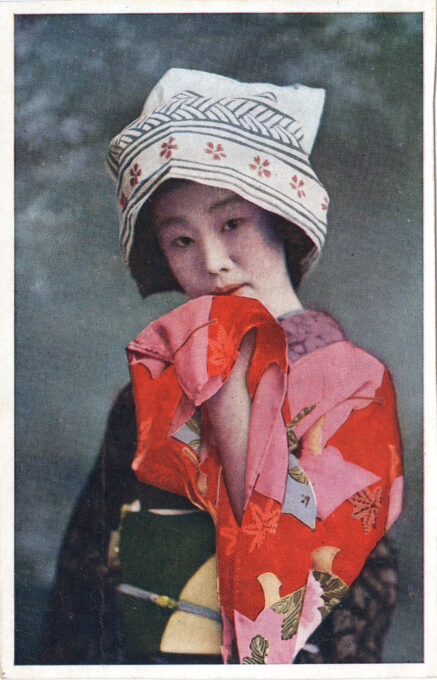
Maid holding tenugui [cotton hand towel], c. 1920. Te (hand) nugu (wipe) is a type of traditional Japanese flat-woven cloth. Unlike terrycloth towels, tenugui can be used in various ways other than just drying hands or bodies and are often artistically decorated in elaborate printed patterns.
See also:
Maiko playing “onigokko” (“devil catch”), c. 1920.
Laundry girls, c. 1910.
“This unhemmed strip of cloth [tenugui], about one yard long and a foot wide, dates as far back as the Nara perod when it was used as a tool for cleaning in shrines and temples. [It] became widely available in the Edo period with the advent of mass cotton production.
“Eirakuya’s 2009 book Irodori tenugui (‘Colorful Hand Towels’) cites the frequent appearance of tenugui in ukiyo-e prints as proof of its ubiquity in the lives of commoners. It also refers to the 1784 publications of a humorous volume displaying the results of a tenugui design competition, launched by comic writer Santo Kyoden, which purportedly involved his samurai patrons, courtesans, and literati of the day in Edo, as evidence of early tenugui creativity.
“Well into the twentieth century, the tenugui served as a common tool in everyday life, used for all kinds of simple kitchen tasks, as a head scarf, and for wrapping and carrying small objects.
“… Although Western-style towels replaced tenugui in most homes by the 1950s, the vividly designed cloths have enjoyed renewed popularity in recent years for their color and resonance with Edo chic … How-to guides available in bookstore lifestyle sections in Japan offer innovative ways to fold tenugui for use in contemporary life.”
– Maiko Masquerade: Crafting Geisha Girlhood in Japan, by Jan Bardsley, 2021

